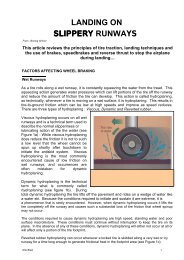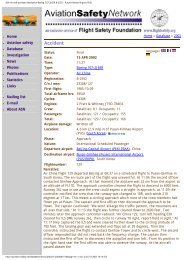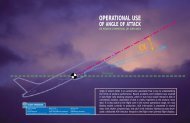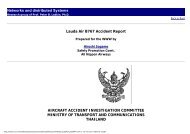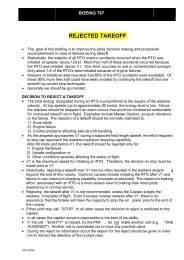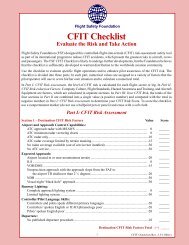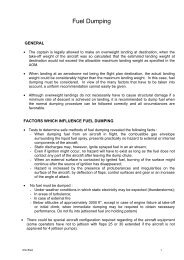Boeing 737-236 series 1, G-BGJL: Main document - Leonardo
Boeing 737-236 series 1, G-BGJL: Main document - Leonardo
Boeing 737-236 series 1, G-BGJL: Main document - Leonardo
Create successful ePaper yourself
Turn your PDF publications into a flip-book with our unique Google optimized e-Paper software.
mm can be anticipatedat peak power, and the calculation showed that thermal stressesin the order<br />
of 29,000 psi would therefore be generated in theliner material. Tests on sample Hastelloy X<br />
material at elevatedtemperatures showed that, at this stress level, the fatigue lifeof the material<br />
would vary between 100 cycles at 980°C to1,000,000 at 815°C. These results serve to emphasise<br />
thevery damaging effects of high temperatures and it can thereforebe argued that hot spots in the<br />
can will suffer rapid localisedcracking within, say, 1,000 flights from new or repair whilstthe cooler<br />
regions would have a vastly greater life. The fatiguelife of the can is thus essentially limited by the<br />
performanceof the cooler, longer-life regions, rather than the performanceof localised hot spots.<br />
1.16.2 Search of existing data on Aircraft Fires<br />
1.16.2.1 Emissions from burning aircraft cabin materials<br />
Much attention has been paid to the emissions from the syntheticfoams used in cabin-seat cushions.<br />
Thermal decomposition of suchfoams in air produces a complex mixture of smoke and gases,<br />
whichnot only varies with the type of foam (eg polyurethane, polyetherurethaneetc) and whether it<br />
has added constituents (eg flame-retardants),but is also dependent upon combustion conditions - eg<br />
flamingor non-flaming (eg smouldering) conditions. However, the othercabin materials such as<br />
wall panels, windows/surrounds, overheadpassenger service unit panels, overhead baggage<br />
compartments,ceiling panels, sealing strips, curtains etc. also produce toxic,irritant gases and<br />
smoke when burnt.<br />
Comprehensive data on the gases emitted from the combustion ofseat-foams and other cabin<br />
materials is contained in a FederalAviation Administration (FAA) report1 (Appendix 15a). These<br />
dataindicate that the well known problems associated with the foamsused in cabin seat-cushions<br />
represent only one part of the generalproblem concerning the products of combustion of aircraft<br />
cabinmaterials.<br />
Polyvinylchloride (PVC) material from cabin panels produces almostas much carbon monoxide as<br />
does polyurethane foam, for the sameweight burnt, but also produces almost six times the<br />
concentrationof the acidic gas hydrogen chloride.<br />
Polyurethane foam produces less hydrogen cyanide than modacrylicmaterial, which can be used for<br />
curtains, carpets etc. Relativelysmall weights of any such materials can produce substantial<br />
concentrationsof toxic/irritant gases and smoke when burnt within an aircraftcabin volume.<br />
eg. The burning of only some 5.7 lbs of modacrylic curtain materialin a<br />
cabin volume of about 6,000 cubic feet, will produce a critical<br />
concentration of 200 parts per million (ppm) of hydrogen cyanide-<br />
sufficient to induce rapid incapacitation and death.<br />
Wool is often preferred to modalcrylics for curtains, carpetsetc (as was the case on G-<strong>BGJL</strong>), but<br />
also produces hydrogen cyanide,although in reduced quantities.<br />
Fluorinated materials which are frequently applied in the formof decorative films to cabin wall<br />
panels (eg 'Tedlar' Polyvinylfluoridefinish on the wall panels of G-<strong>BGJL</strong> at Manchester) emit the<br />
intenselyirritant hydrogen fluoride acidic gas when burnt.<br />
Fibreglass materials generally exhibit much lower toxic/irritantgas emissions, dependent upon the<br />
resin used - eg phenolic fibreglassis superior in this regard to epoxy fibreglass. Such materialscan<br />
still, however, emit large concentrations of particulate -ie 'smoke'.



